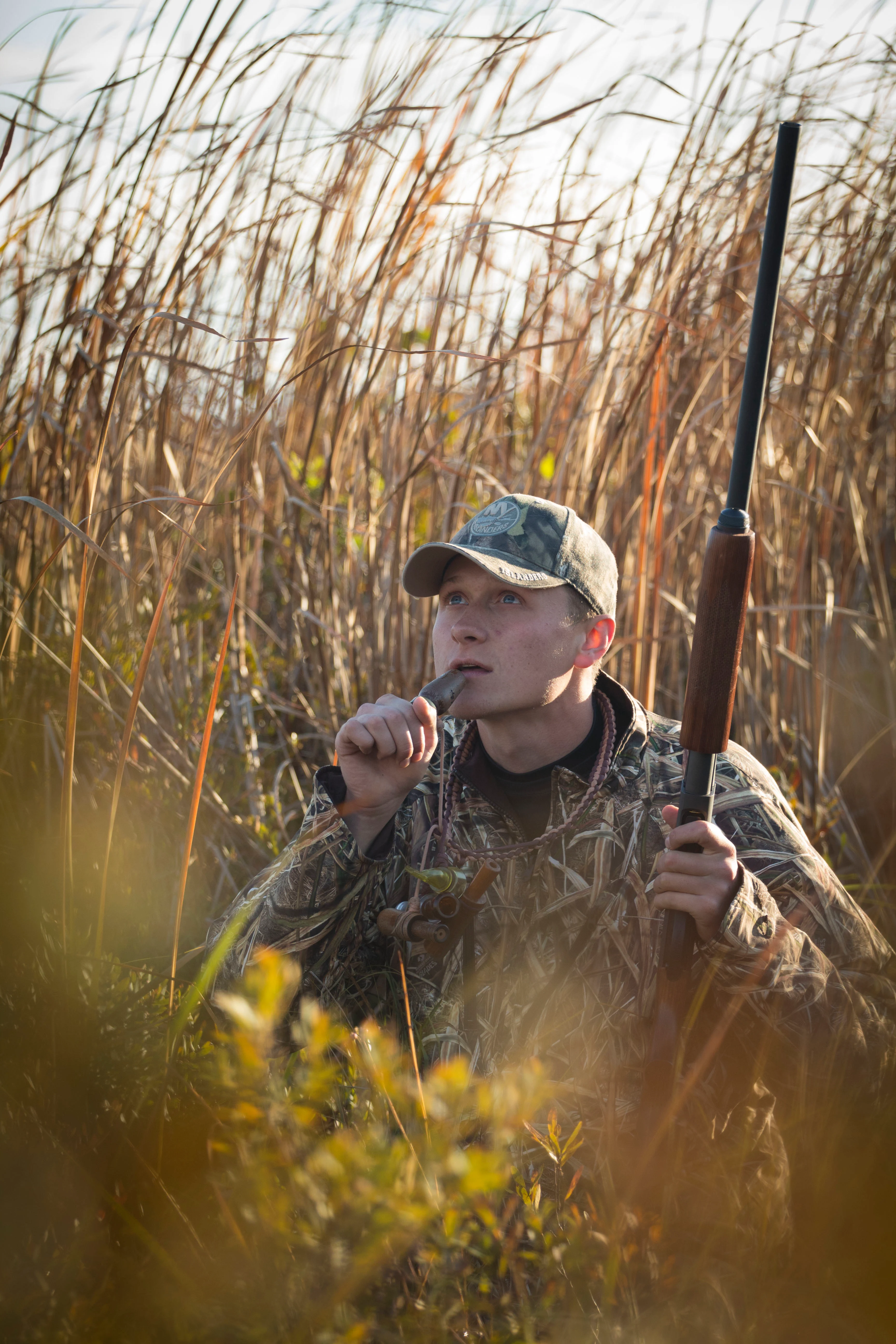Choosing a duck call can be overwhelming, especially if it's your first. For starters, there are hundreds upon hundreds of models to choose from. Then, you have to decide on how much you're willing to spend, the materials, the number of reeds, and what you want your call to do. Over time, most hunters will accumulate multiple calls on their lanyard to cover a wide range of applications.
Before you can get to a lanyard full of calls, you have to start with one. And that's where I come in. To help narrow down your search, I created this basic guide with the five main considerations for choosing a duck call. This will help you build a basic understanding of the different types of calls and materials. Then you can figure out what's best for you. Here's what to consider when buying your first duck call.

Decide on a Budget
The first question you should ask yourself is, how much are you willing to spend on a duck call? A call shouldn’t be a one-and-done purchase, but rather an investment meant to last, theoretically, a lifetime. “I think it really depends on how much you're going to use the call," says call maker Bill Saunders. "If you’re using it once or twice a year, then something for $25 or $30 can get you by." Saunders continued to explain that if you're a more serious hunter, then stepping up to the level of materials will be beneficial.
No matter what your skill level as a hunter or caller is, the first step in buying a new call is setting a budget and sticking to it. This will allow you to focus on specific materials, reed design, volume, and purpose. Once you have your price set you can start to look at other features.
Choose a Reputable Maker
If you’re looking at a duck call as the investment it is, then buying from a recognized and reputable call maker should be a top priority. The good news is there are plenty of excellent names out there, which, in turn, can make the decision-making process a little more difficult. That said, here is a list of some of the top call makers in the country.
Why go with a recognized call-maker? Service after the sale is vital, and these individuals have proven themselves to be some of the best at providing that service. Education, advice, and availability also factor into the equation. Rather, I want a maker I can actually write or call with questions or comments, and those listed here can, again, provide those answers.
How Many Reeds Should You Get?
A reed is a thin synthetic polyester material that is the beating heart of a duck call. The reed or reeds are the only moving part of the call, aside from the air being forced past (over/under) the reed/reeds themselves. That air pushed through the reeds creates a vibration, and it’s that channeled vibration that creates the sounds we hunters, along with the ducks, hear and, hopefully, respond to.
Today, 99 percent of modern duck calls sport either a single or double reed design. However, there are a handful of tripe reed calls on the market, such as Phil Robertson’s Triple Threat, Sure Shot’s Classic Triple Reed, and David Jackson’s (formerly PS Olt) TR-98 Triple Reed.
Is one reed better than two? Is two reeds better than three? Much of the decision here lies in personal preference, desired calling range, and ability.
Single reed calls are extremely versatile. They can do everything a mallard duck can do, and some things they can’t. Single reeds also have excellent volume and range. The downside to single reed calls is that there is usually a steeper learning curve. Blowing a single reed correctly requires good calling mechanics and a solid calling fou in terms of air control and delivery. Another drawback is that single reeds have a tendency to ‘stick’ or lock up more frequently than double reeds; however, that’s debatable in many calling circles.
Double reed calls are user-friendly, meaning they have more forgiveness than single reed calls. They're usually soft and subtle and great for timber hunting and short-distance calling. The obvious drawback is they don't have the volume of a single reed, and due to the additional ‘moving part,’ the double reed requires more air to be introduced into the call.
Triple reed calls have many moving parts, requiring a higher degree of control and more air. These calls are less common on a lanyard, but some experienced hunters prefer them.

Materials
The material a duck call is made of affects several aspects, including sound, durability, required maintenance (if any), and price. The three most common materials are wood, polycarbonate (plastic), and acrylic.
Wood
Wooden duck calls sound nice. They’re mellow and often soft and subtle. However, different types of wood, or rather different densities (hardness), will produce different sounds, i.e., quiet, higher volume, raspy, or crisp and clear. Some of the more traditional wood used to make duck calls are walnut, osage orange/hedge, cocobolo, maple, and bocote. Though, call makers do experiment with others, including Diamondwood (Dymondwood) laminate, African Blackwood, and cherry. Wood calls require the highest degree of maintenance, e.g. drying, cleaning, and oiling, of any of the three types of materials.
Polycarbonate
Polycarbonate calls, or polys, are made by melting plastic and injecting the liquid plastic into a mold. The calls are then trimmed, buffed, and assembled by combining the barrel or mouthpiece with the insert, the part of the call that contains the wedge and reed/reeds. Raw polycarbonate pellets are available in a wide variety of colors, thus allowing call makers to offer such shades as bourbon, red, smoke, yellow, blue, chartreuse, and pink. Poly calls are incredibly durable, maintain their sound quality through all temperature ranges, and, due to the way they’re made, are typically the least expensive.
Acrylic
Like wood, acrylic duck calls are ‘turned’ or mechanically carved one at a time on a lathe. As such, acrylics are labor intensive, thus putting them at the top of the price list, with an average cost of from $125 to $250, depending upon the work involved from start to finish. Because it’s so hard, acrylic plastic makes an extremely rugged duck call, one unaffected by weather, temperature, or neglect. This variable, too, contributes to acrylic’s high sound clarity, as well as the ability to produce high volume, a desirable factor for those hunting over open water or on big river systems like the Mississippi or Columbia.
Types of Calls
Before we take a quick look at my lanyard, let me say this. Most duck hunters, even those new to the sport, are familiar with calls that produce the hen mallard’s recognizable quack in any of its different forms. What might not be so well-known are the ‘other’ calls on today’s market. Calls in skilled hands can make a long list of duck sounds aside from the traditional quack. Here are some of my favorite calls for specific species:
Drake Mallard: Duck Commander Mallard Drake
Widgeon: Buck Gardner’s 6-in-1
Pintail: Slayer Calls Whistler’s Mother
Diving Ducks: Haydel’s DC-14 Diver Call
Blue-Winged Teal: Primos Blue Wing Teal
Gadwall: DJ Calls’ PGD-17 Gadwall
Wood Ducks: Big Lake Calls’ Perfect Woodie
Do you need all of them? No, but over time, you’ll invest in all of them. Trust me, I know firsthand. That said, my working field lanyard holds an acrylic single reed, an acrylic double reed, and a 6-in-1 whistle given to me by Buck Gardner himself. I do carry a second double reed in my Rig ‘Em Right Lowrider backpack, just in case something goes sideways while I’m in the field. Armed with these two reeded calls and the whistle, I’m always prepared for anything I need to do on the water.
One last note: Invest in a good lanyard, one that holds your call or calls securely and lets them ride high enough on your chest that they’re easily accessible and out of the water.


